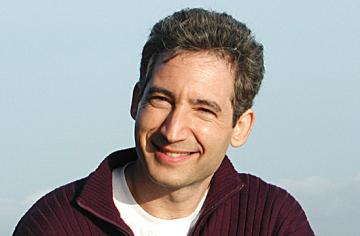Why science matters to Brian Greene
- Krista Zala

How does three go into six? When string theorist Brian Greene asked it of a Grade 2 class, a student eagerly ran to the board, drew a massive 6 and wrote a tiny 3 inside. While that wasn’t exactly what he was looking for, he said that the spirit of eagerly giving your best shot at an answer was bang-on for a budding scientist.
In his lively sold-out talk on Feb 1, Greene pitched science as just that: an uninhibited journey into the unknown. He used the ongoing search for a Grand Unified Theory that would describe the behaviour of all matter, from the very large to the very small, to make his case for the dramatic history of bold thinking. Starting with Newton’s mathematical descriptions of gravity and how it transformed our understanding of the universe, Greene chronicled the increasing complexity laid out by Einstein with the general and special theories of relativity, and explained what he considers today’s best shot at explaining how it all fits together: string theory.
Brian Greene has been bringing the sophisticated concept of string theory into the public eye since his 1999 book The Elegant Universe. A professor of physics and mathematics at Columbia University, he has popularized string theory in books, speaking tours, and in media including the Colbert Report and an upcoming NOVA mini-series.
His 2011 book, Hidden Reality: Parallel Universes and the Deep Law of the Cosmos, discusses the possibility of our universe being one of many in a grand multi-verse.
This early leg of his speaking tour brought him to Victoria as the Vifor Pharma Distinguished Lecturer for 2011, where he guided the audience through science’s incremental discoveries in answering the biggest question of physics.
“Greene was fantastic. He took an arcane topic that only specialists understand and made it interesting to the entire audience,” said Robert Kowalewski, chair of UVic’s Physics and Astronomy. “We’re interested in engaging the public in science, and who better than one of the best science communicators in the world?”
Reaching back more than 300 years, Greene explained that Newton’s breakthrough in understanding gravity could account for a falling apple and a revolving planet alike, but couldn’t explain how gravity actually worked. The premise is puzzling: how can two objects exert influence on each other when there’s no direct connection, no mode of transmission, nothing but empty space between them?
It took Einstein years to sort out the mechanism: it was space itself, stretching like a rubber sheet across gas stations and galaxies, that dictated the motion of matter. Not only did objects distort the fabric of space-time, but those curves in the cosmos in turn affected the objects’ movement through it. This description sounds tricky to verify, but it includes the prediction that light is bent by massive bodies, which was confirmed by astronomical observations in 1919.
The problem with the laws describing the larger parts of the universe is that they conflict with quantum mechanics, which govern actions of molecules, atoms and subatomic particles. The smooth movements of the big scale is irreconcilable with the jittery chaos of the ultra-small within our current understanding of physics, but there was a time, at the moment of the Big Bang, when one set of rules had to apply to everything.
This is where string theory comes in as a possible means of explaining it all. It posits that zooming in far smaller than the dots of atoms and quarks reveals tiny filaments of energy that vibrate like strings of a violin. (These filaments are truly tiny: if an atom were the size of the universe, a string would be no bigger than a tree.) Each pattern of vibration expresses a shape, and they collectively gives rise to the matter in our universe.
The trouble is, the math behind it doesn’t work with our three dimensions of space and one of time. It does work in 10 dimensions—some of which may be curled like a sheet of paper, far too small for our lumbering selves to detect, explained Greene. But the math that comes from string theory could explain why the 20 or so major physical constants that govern our physics have the values they do.
The ineffably vast number of possible shapes of these vibrating filaments might even mean that in the Big Bang, universes opened up in pockets, each with its own set of shapes. “We don’t know if this is the right way of thinking of physics,” said Greene, “but that’s why the drama of this story is so exciting: we don’t know how it will turn out.”
Part of Greene’s drive to bring science into the public sphere is his contention that the health of a democracy relies on having a scientifically informed and engaged populace. This conviction also led him to co-found New York City’s World Science Festival in 2008, which he says celebrates scientific feats and establishes its place in culture as music, arts and food festivals do for their causes. The higher our scientific intellect takes us, the deeper we can engage with the world. “Nurturing this kind of creative thought is the only way we stand a chance of fashioning our brightest future,” he explained. “That to me is why science matters.”

